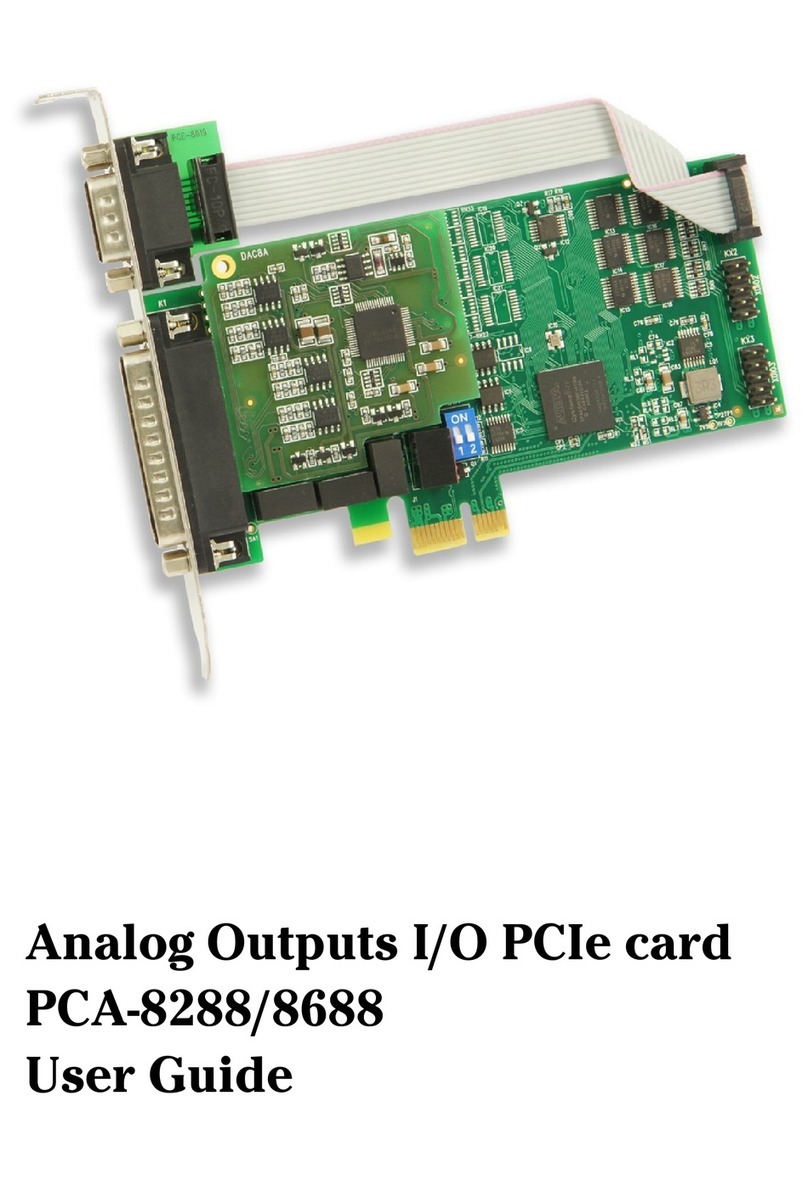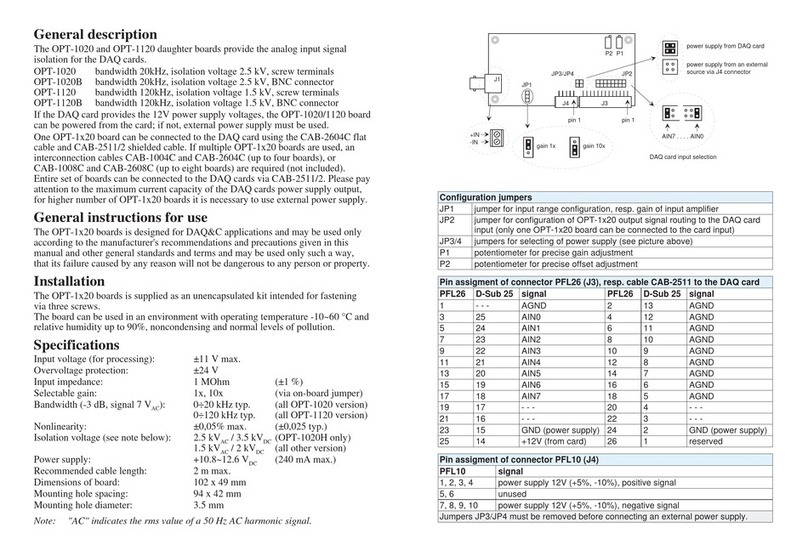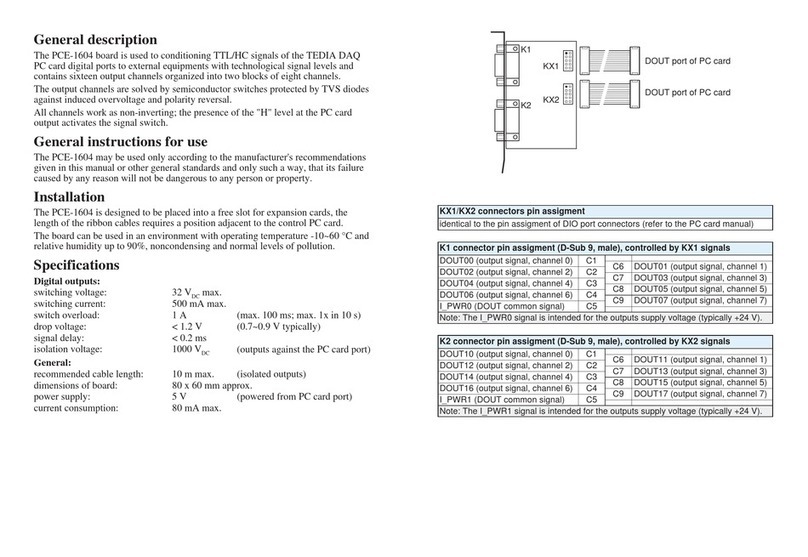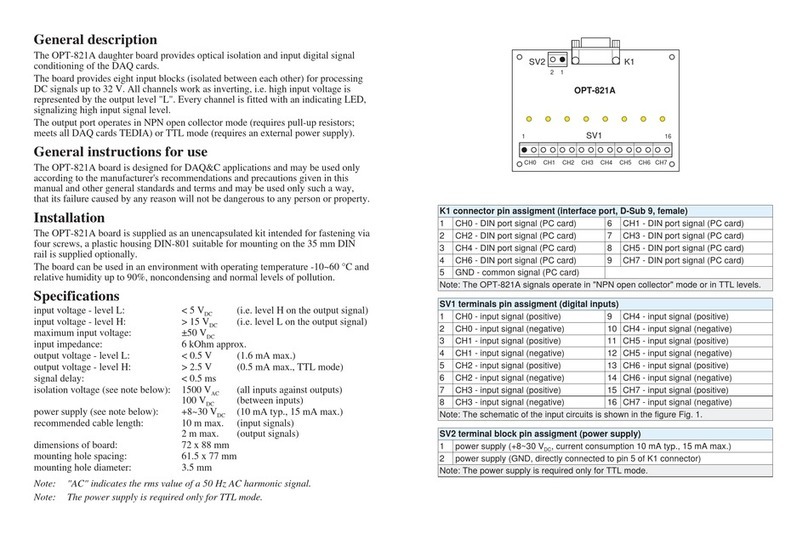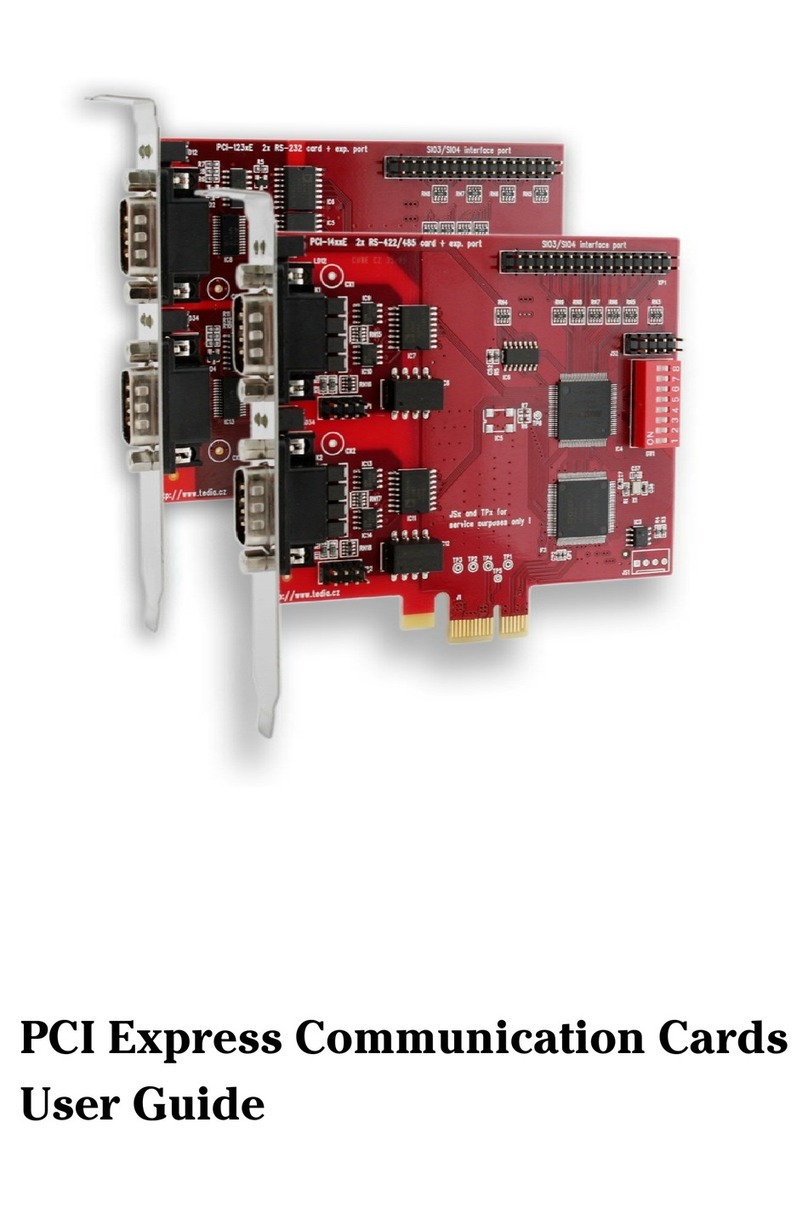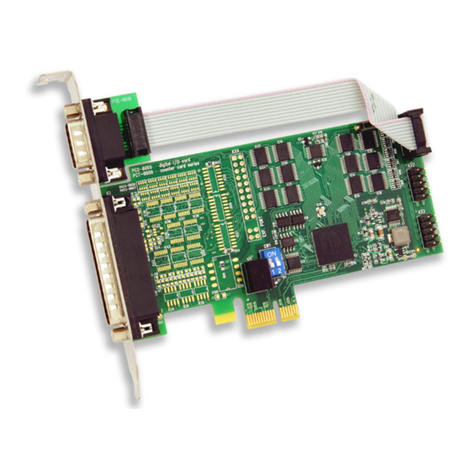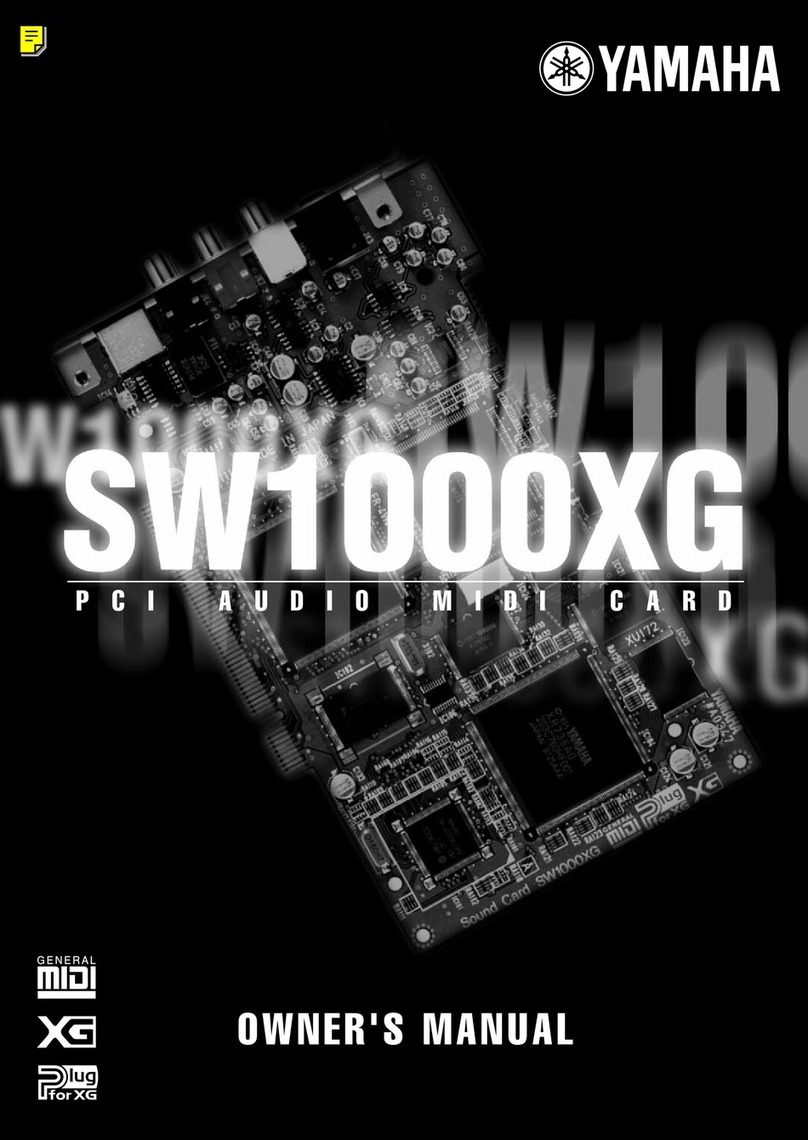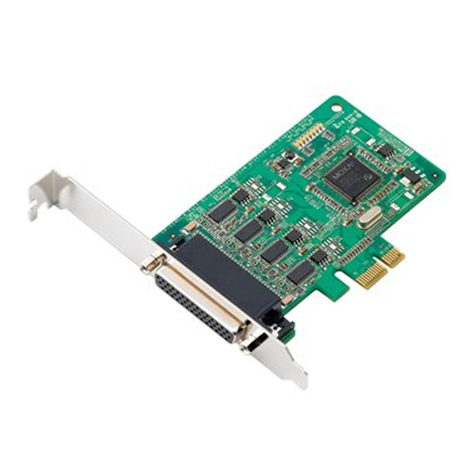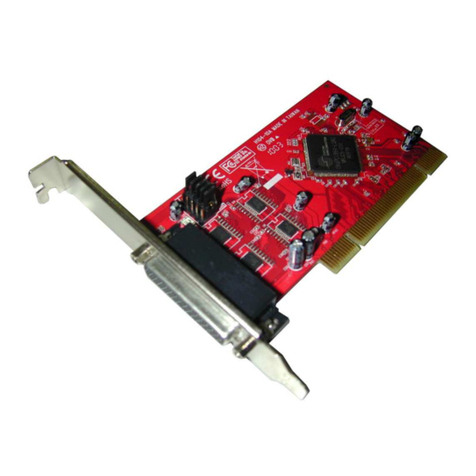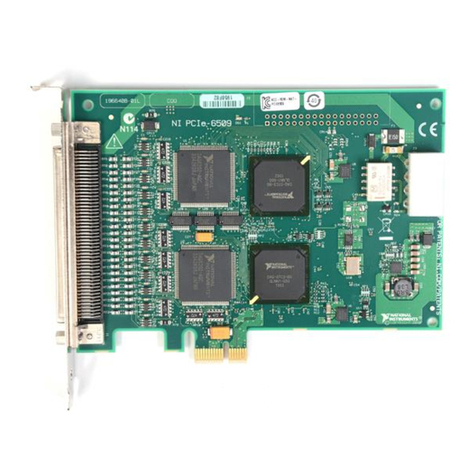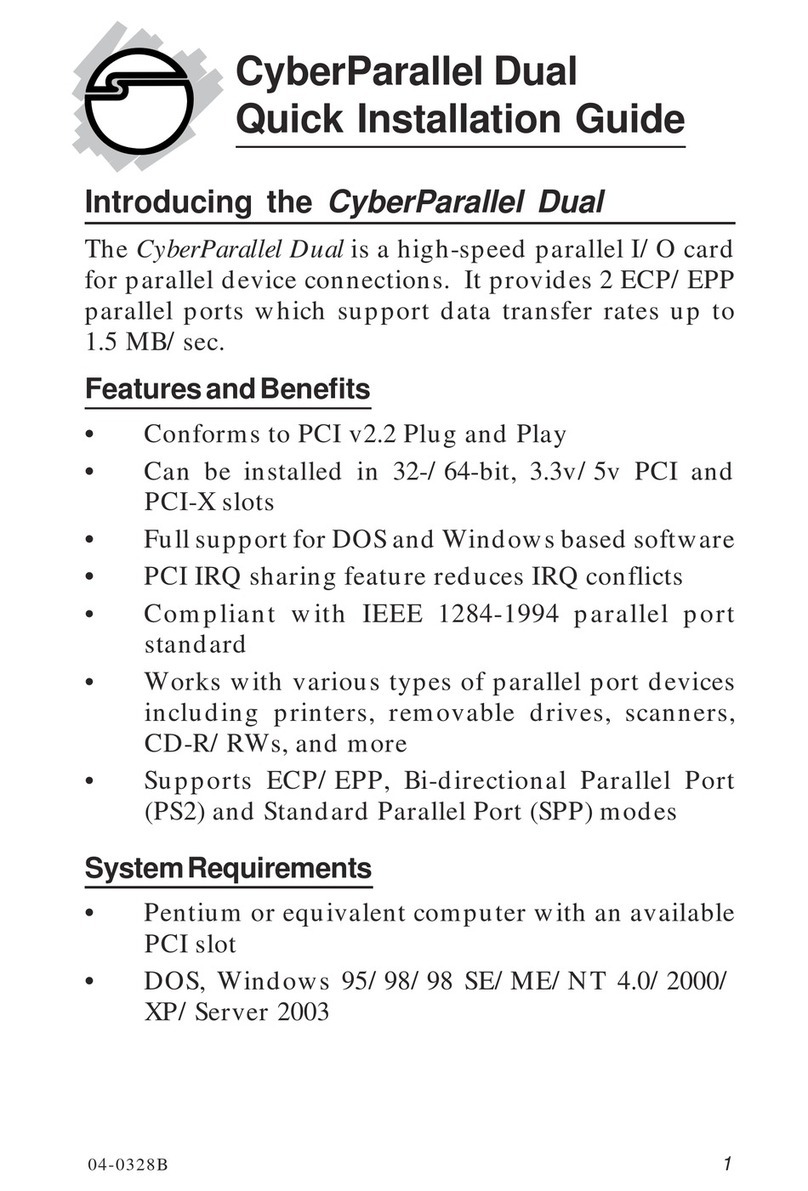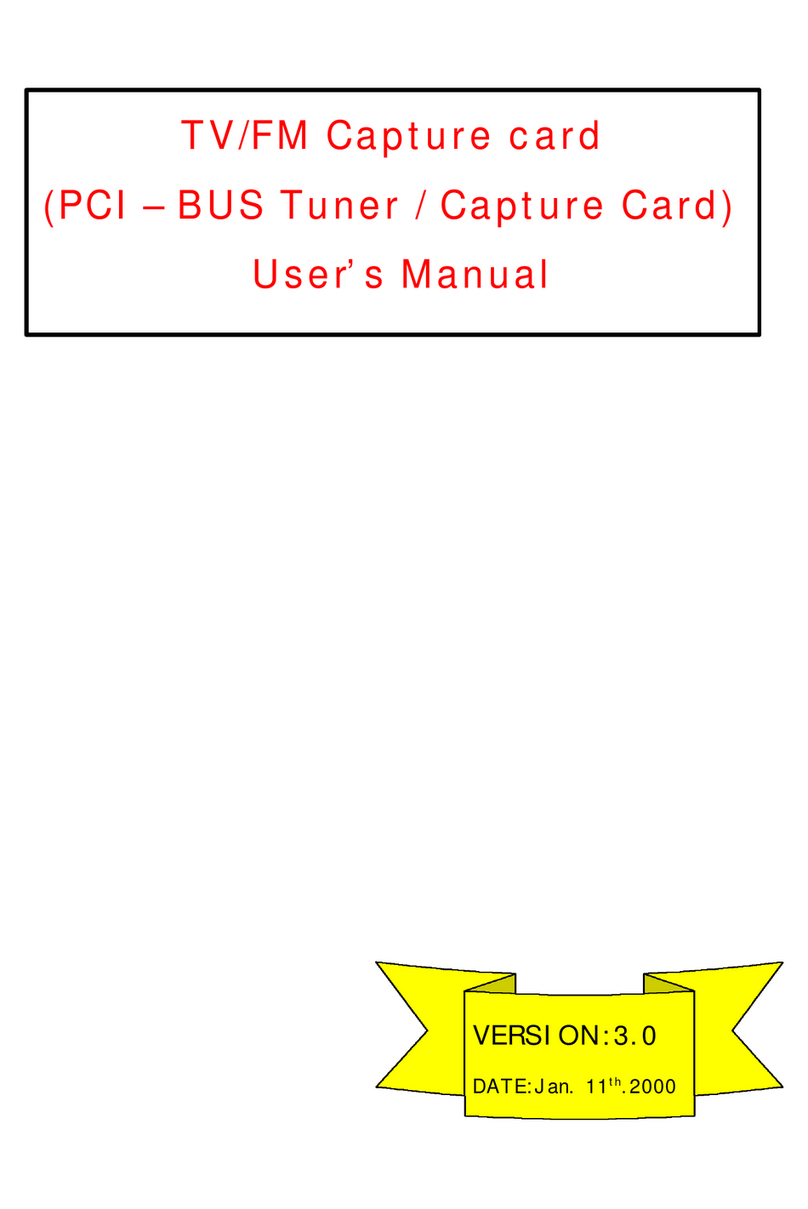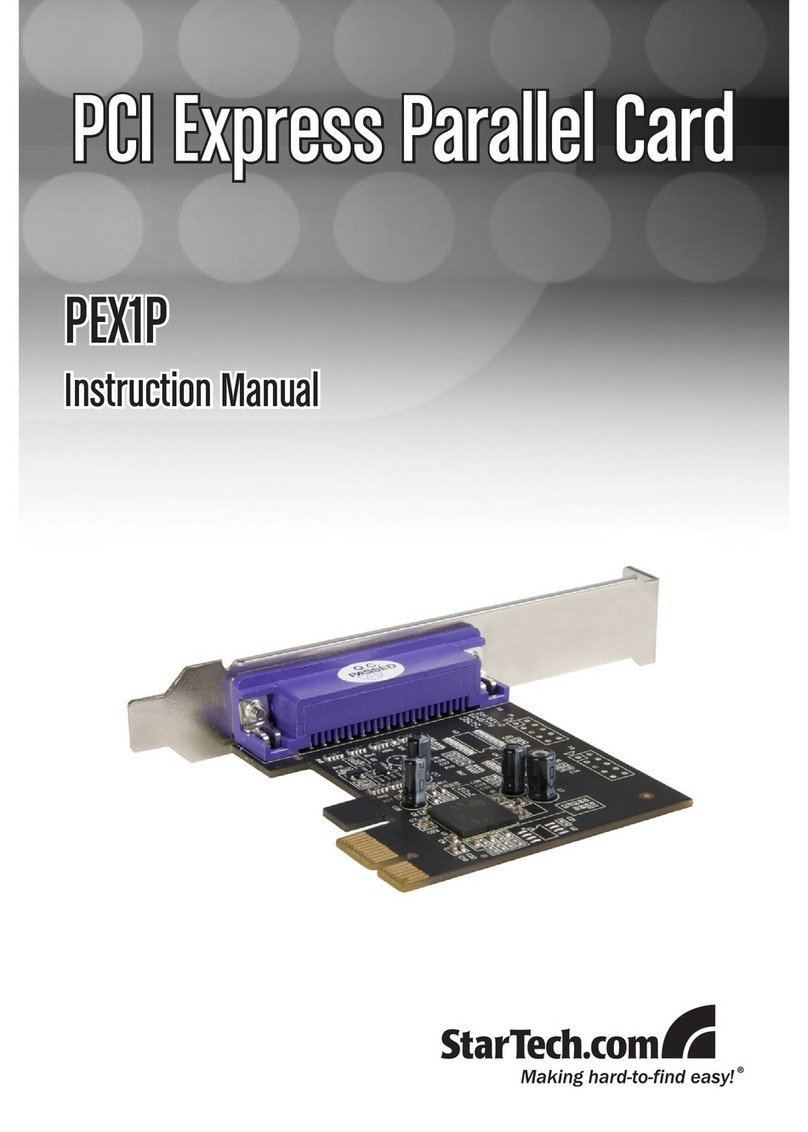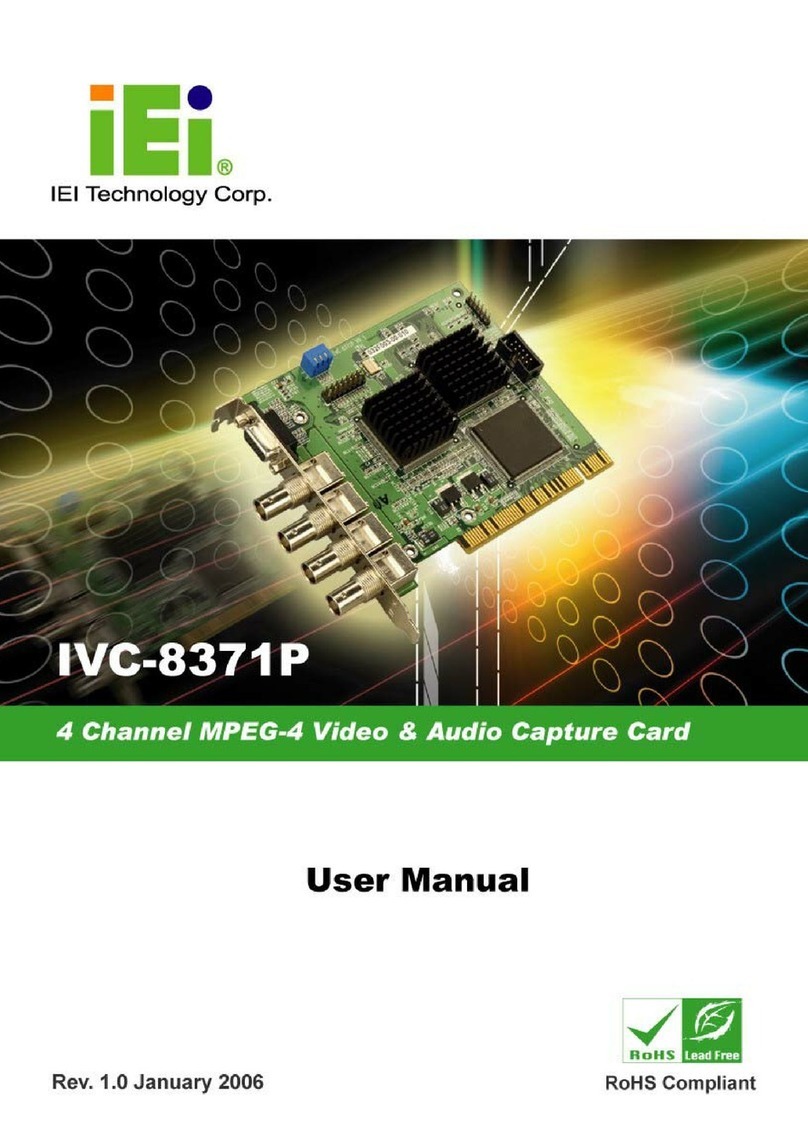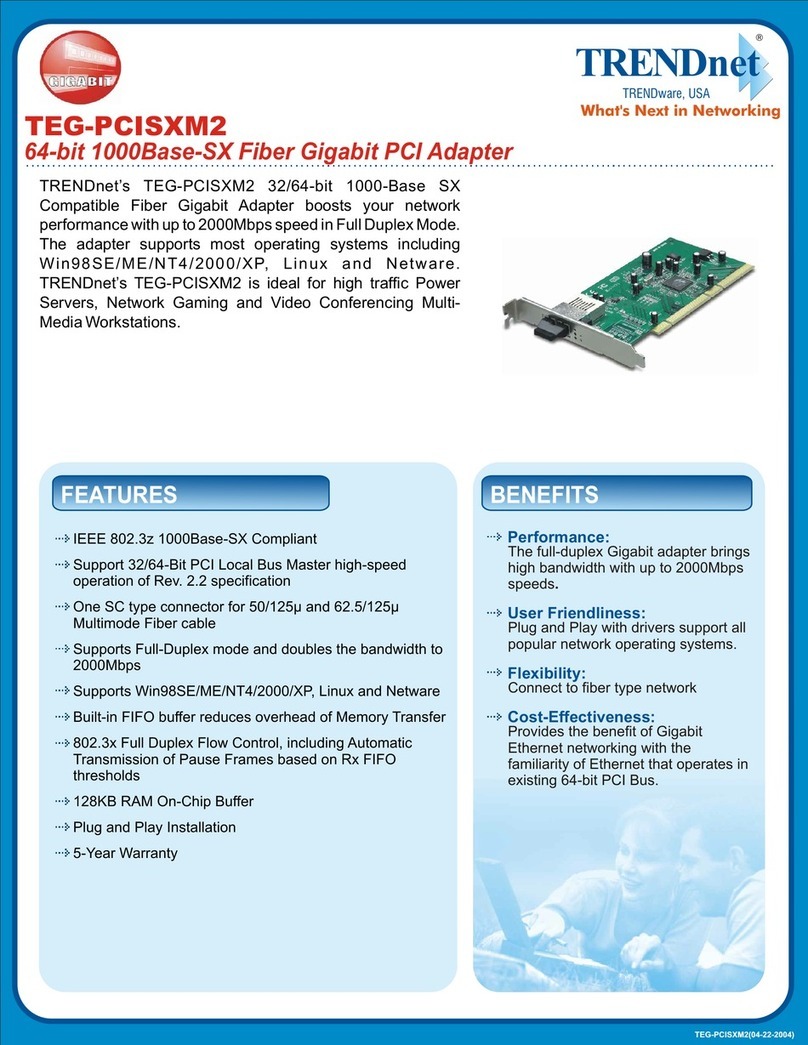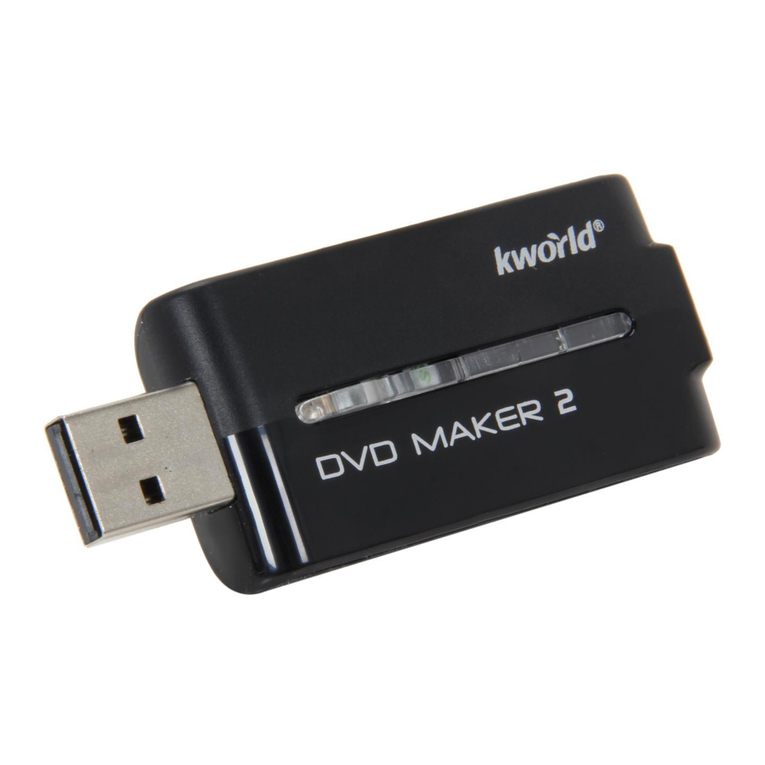TEDIA PCD-8104 User manual

Digital I/O PCIe card
PCD-8104/8105/8106
User Guide

Manufacturing, sales office, service center, technical support and headquarters:
address: TEDIA®spol. s r. o.
Zábělská 12
31211 Plzeň
Czech Republic
website: http://www.tedia.eu
phone/e-mail: https://www.tedia.eu/contacts
tech. support: https://www.tedia.eu/support
Trademarks:
TEDIA is a registered trademark of TEDIA®spol. s r. o. All other trademarks or registered
marks in this manual belong to their respective owners.
Disclaimer:
This manual has been carefully reviewed for technical accuracy. In the event that technical or
typographical errors exist, TEDIA®reserves the right to make changes to subsequent editions
of this document without prior notice to holders of this edition.
TEDIA®provides this document “as is,” without warranty of any kind, either expressed or
implied, including, but not limited to, its particular purpose. TEDIA®reserves the right to make
improvements and/or changes to this manual, or to the products and/or the programs
described in this manual, at any time.
Information provided in this manual is intended to be accurate and reliable. The reader
should contact TEDIA®, if errors are suspected. In no event shall TEDIA®be held liable for any
form of damage arising out of or related to this document or the information contained in it.
Copyright © 1994÷2015 TEDIA®spol. s r. o., All rights reserved.
My DAQ Card Details:
type of card: . . . . . . . . . . . . . . . . . . . . . . . . . . . . . . . . . . (e.g. PCD-8104)
serial number: . . . . . . . . . . . . . . . . . . . . . . . . . . . . . . . . . . (e.g. 80410108)
purchase date: . . . . . . . . . . . . . . . . . . . . . . . . . . . . . . . . . .
card owner: . . . . . . . . . . . . . . . . . . . . . . . . . . . . . . . . . .

CE Declaration of Conformity, WEEE
1. Introduction
1.1 Description . . . . . . . . . . . . . . . . . . . . . . . . . . . . . . . . . . . . . . . . . . . . . . . . . . . I - 1
1.2 General instructions for use . . . . . . . . . . . . . . . . . . . . . . . . . . . . . . . . . . . . . . I - 1
1.3 Note on the contents of the manual . . . . . . . . . . . . . . . . . . . . . . . . . . . . . . . . I - 1
1.4 New firmware versions and customer´s firmware . . . . . . . . . . . . . . . . . . . . I - 1
2. Specifications
2.1 Digital inputs . . . . . . . . . . . . . . . . . . . . . . . . . . . . . . . . . . . . . . . . . . . . . . . . . . I - 2
2.2 Digital ports . . . . . . . . . . . . . . . . . . . . . . . . . . . . . . . . . . . . . . . . . . . . . . . . . . . I - 2
2.3 Interrupt logic . . . . . . . . . . . . . . . . . . . . . . . . . . . . . . . . . . . . . . . . . . . . . . . . . I - 2
2.4 General data . . . . . . . . . . . . . . . . . . . . . . . . . . . . . . . . . . . . . . . . . . . . . . . . . . . I - 3
3. Installation
3.1 Introduction . . . . . . . . . . . . . . . . . . . . . . . . . . . . . . . . . . . . . . . . . . . . . . . . . . . I - 4
3.2 Hardware configuration . . . . . . . . . . . . . . . . . . . . . . . . . . . . . . . . . . . . . . . . . . I - 4
3.3 Installation . . . . . . . . . . . . . . . . . . . . . . . . . . . . . . . . . . . . . . . . . . . . . . . . . . . . I - 4
3.4 Location of switches and connectors . . . . . . . . . . . . . . . . . . . . . . . . . . . . . . I - 4
3.5 Connector pin assignment . . . . . . . . . . . . . . . . . . . . . . . . . . . . . . . . . . . . . . . I - 4
4. Digital Inputs and Ports
4.1 Introduction . . . . . . . . . . . . . . . . . . . . . . . . . . . . . . . . . . . . . . . . . . . . . . . . . . . I - 5
4.2 Description of digital inputs . . . . . . . . . . . . . . . . . . . . . . . . . . . . . . . . . . . . . . I - 5
4.3 Description of digital ports . . . . . . . . . . . . . . . . . . . . . . . . . . . . . . . . . . . . . . . I - 6
4.4 Interrupt logic . . . . . . . . . . . . . . . . . . . . . . . . . . . . . . . . . . . . . . . . . . . . . . . . . I - 6
Appendix - Tables and Figures
Notes
Table of Contents
PCD-8104, PCD-8105, PCD-8106 User Guide - Table of Contents
rev. 12.2015

CE Declaration of Conformity
All TEDIA®products described in this user guide comply with
the essential requirements of the following applicable
European Directives:
• Electromagnetic Compatibility (EMC) Directive 2014/30/EU
• RoHS Directive (EU) 2015/863 amending Annex II to
Directive 2011/65/EU
The CE Declaration of Conformity original document is stored
at the manufacturer and its copy may be provided on request.
Waste Electrical and Electronic Equipment
(WEEE)
This symbol indicates that waste products should be disposed
of separately from municipal household waste according to
WEEE Directive 2012/19/EU of the European Parliament and
the Council on waste electrical and electronic equipment
(WEEE). All products at the end of their life cycle must be
sent to a WEEE collection and recycling center. Proper WEEE
disposal reduces environmental impact and the risk to human
health due to potentially hazardous substances used in such
equipment. Your cooperation in proper WEEE disposal will
contribute to the effective usage of natural resources.
PCD-8104, PCD-8105, PCD-8106 User Guide - CE Declaration of Conformity, WEEE
rev. 12.2015

1.1 Description
The PCD-8104/8105/8106 are add-on PCI Express cards intended especially for laboratory
and industrial automation and measuring systems.
The PCD-8104/8105/8106 cards provide especially these features:
• 24 isolated digital inputs; signal levels depending on the type of card (5 V or 24 V)
• three 8-bit bidirectional digital ports, software configurable as input or output
• IRQ logic with interrupt sources derived from rising or falling edge of each digital port
signal (i.e. 96 individually programmable interrupt sources) and internal timer
Available types and versions of cards:
PCD-8104 standard format card intended for 5 V signal levels (common GND)
PCD-8104/LP low-profile format card of PCD-8104
PCD-8105 standard format card intended for 24 V signal levels (common GND)
PCD-8105/LP low-profile format card of PCD-8105
PCD-8106 standard format card intended for 24 V signal levels (common 24 V)
PCD-8106/LP low-profile format card of PCD-8106
In the following text, unless otherwise stated, the designation PCD-810x applies to all
types and versions of card.
1.2 General instructions for use
The PCD-810x card is suitable for installation in either office or industrial computers that are
fitted with the PCI Express bus (Gen 1 compatible).
Cable types and their maximum length are described in paragraph 2.4 General data.
Caution:
The cards are designed for DAQ&C applications and may be used only according to the
manufacturer's recommendations and precautions given in this manual and other general
standards and terms and may be used only such a way, that its failure caused by any reason
will not be dangerous to any person or property.
1.3 Note on the contents of the manual
This manual contains all information related to card features, I/O connectors etc., but does
not include a description of installing and using drivers.
For information about drivers and programming check the dedicated documentation.
1.4 New firmware versions and customer´s firmware
The PCD-810x card is based on a FPGA unified core providing implementation of PCI
Express bus and all peripheral circuitry, e.g. solution that gives maximum control and
supervision over full functionality. High concentration of control algorithms within FPGA
allows to add or modify functions without redesign the board (e.g. firmware with added
special custom features or a build completely new custom firmware).
A simple software utility for user-friendly firmware upgrade is available.
1. Introduction
PCD-8104, PCD-8105, PCD-8106 User Guide
rev. 12.2015 I - 1

2.1 Digital inputs
Input type:
PCD-8104, PCD-8104/LP HC/HCT/TTL
PCD-8105, PCD-8105/LP 24 V, common GND (designed for PNP outputs)
PCD-8106, PCD-8106/LP 24 V, common 24 V (designed for NPN outputs)
Number of inputs: 24
Parameters of HC/HCT/TTL type inputs:
signal level L: < 0.8 V
signal level H: > 2.0 V
input impedance: 10 kOhm approx. (pull-up resistor against 5 V)
overvoltage protection: -10 V / +15 V
Parameters of 24 V type inputs:
signal level L: < 5 V (see Fig. 4 and 5 in Appendix)
signal level H: 15÷30 V (see Fig. 4 and 5 in Appendix)
input impedance: 10 kOhm approx.
overvoltage protection: ±40 V max. 1 s
Isolation voltage: 1000 VDC (standard version of the card)
600 VDC (card with ESD-X1 option)
Note: ESD-X1 option includes Surge Arrester (protection of the isolation barrier).
2.2 Digital ports
Number of ports: three 8-bit bidirectional ports
Operating levels: HC/HCT/TTL
Load impedance of outputs: 500 Ohm min.
Note: Digital bidirectional ports are not protected against overvoltage, stresses outside the
range 0÷5 V will may cause permanent damage.
The digital ports in the output mode are durable to permanent short-circuit against
GND while maintaining the maximum current of the 5V power source (see
paragraph 2.4 General data).
2.3 Interrupt logic
Interrupt sources: timestamp IRQ generator (1÷255 ms),
all digital ports
Interrupt trigger event: timestamp generator overflow,
any combination of rising or falling edges on all
digital ports and digital inputs
2. Specifications
PCD-8104, PCD-8105, PCD-8106 User Guide
rev. 12.2015 I - 2

2.4 General data
Bus type: PCI Express (x1, Gen 1)
PCI ID: VID=1760H, DID=0804H(PCD-8104, PCD-8104/LP)
VID=1760H, DID=0805H(PCD-8105, PCD-8105/LP)
VID=1760H, DID=0806H(PCD-8106, PCD-8106/LP)
Bus power consumption: 300 mA typ. @ 3.3 V (500 mA max.)
150 mA typ. @ 12 V (500 mA max.)
Internal power supply: 700 mA max. @ 5 V (see note below)
Board dimensions:: 56 x 128 mm approx. (PCE-8019 not included)
Connectors: D-Sub 25 - male (digital inputs)
10 pin header type (DIO ports 0, 1 a 2)
Operating temperature: 0÷60 °C
Storage temperature: -20÷70 °C
Operating humidity: 10÷90 %, noncondensing
Recommended cable length: shielded cables, 2 m max.
Note: The internal 5V power supply voltage is generated by the on-board circuits from the
12V PCI Express bus power source and is used to supply the DIO ports and also to
supply PCE-16xx series external boards (see description of KX1÷KX3 connectors).
The total current of all 24 DIO signals when output mode is selected, including the
current consumption of PCE-16xx boards, must not exceed the permitted value.
PCD-8104, PCD-8105, PCD-8106 User Guide
rev. 12.2015 I - 3

3.1 Introduction
Attention has been focused on achieving a high quality and reliability during the
manufacturing process and attention was also paid to an inspection of the card before
being shipped to you. Detailed reading of this guide and following the instructions
precisely are highly recommended for achieving full quality and to prevent any damage
during installation. For further information see manufacturer's website http://www.tedia.eu.
3.2 Hardware configuration
The PCD-810x card contains a single configuration element - a two-segment DIP switch (the
status of this switch can be read by the program to identify multiple cards as CardID value).
Check Figure 1 in Appendix of this manual for more information.
3.3 Installation
Important Warning:
While installing the card, please follow the principles for handling the circuits, which are
sensitive to the electrostatic discharge damage. Touch the card carefully only by the edges,
and do not touch the components or metal contacts on the bottom of the card.
The computer must be switched off before the card is installed. Always disconnect the
power supply cord and other cables connected to the PC!
The cards may be stored only in an antistatic wrapper outside of the computer. Failure to
comply with the rules listed above may lead to damage of the sensitive circuits of the card,
or even of the whole computer.
After removing the slot cover plate, plug the configured card into a free slot for expansion
PC cards and fix it in place.
If you plan to use the digital ports DIO1 and DIO2 of standard format card, install the
PCE-16xx series board (not included in the delivery package of the card) into the next
position and connect the flat cables. Similarly, if you plan to use the digital ports DIO0,
DIO1 and DIO2 of low-profile card, install the PCE-8025/LP adaptor board (not included in
the delivery package) into the next position and connect the flat cables.
Note: In the event of any queries, please contact the manufacturer's technical support.
See http://www.tedia.eu for more contact information.
3.4 Location of switches and connectors
See the Appendix, Figure 1 for location of configuration switches and connectors.
3.5 Connector pin assignment
The connector pin layouts are shown in Table 1 through Table 3, the connector pin
assignment is shown in Figure 2 (all in Appendix of this manual).
3. Installation
PCD-8104, PCD-8105, PCD-8106 User Guide
rev. 12.2015 I - 4

4.1 Introduction
The PCD-810x card provides 24 isolated digital inputs (signal levels depending on the type
of card) and three 8-bit bidirectional digital ports.
All digital inputs (identified as DIN00÷DIN23) use the D-Sub 25 connector located on the
card bracket, three digital ports (identified as DIO0, DIO1 and DIO2) use header type
connectors located at the back edge of the card.
In case of the standard format card (ie. PCT-842x), the DIO0 port is accessed on the card
bracket via adapter cable PCE-8019 terminated with D-Sub 9 connector. Remaining two
ports (ie. DIO1 and DIO2) can be accessed via adapter cable PCE-1620 (card bracket with
D-Sub 9 connector), or other types from the PCE-16xx series adapter boards.
Note: Unlike the adapter cable PCE-8019, the PCE-16xx boards are not included in the
delivery package of the card.
In case of the low-profile format card (ie. PCD-810x/LP) all three ports DIO0, DIO1 and
DIO2 can be accessed via adapter cable PCE-8025/LP (low-profile card bracket with D-Sub
25 connector); there are currently no other option available.
Note: The PCE-8025/LP adaptor board is not included in the delivery package of the card.
The signal direction of DIO port (ie. input or output option) can be selected independ for
each 8-bit port (it is not possible to select direction individually for each of the eight signals
of one DIO port) from the user software.
The port direction and output data after computer is turned on or restarted are stored in the
on-board EEPROM memory and can modify by the software utility (by default, all ports are
set as input).
4.2 Description of digital inputs
All cards of the PCD-810x series contain 24 isolated digital inputs they differ from each
other only by signal levels and input connections.
The PCD-8104 card digital inputs work with HC/HCT/TTL levels and use HCTMOS circuits
providing high input impedance, very low leakage current and protection diodes. The
unconnected state of inputs represents the H logic level generated by pull-up resistors 10
kOhm against a voltage of 5 V, and the inputs can be therefore also used to direct
connecting of floating contacts.
Check the Appendix, Figure 3 for detail information.
The PCD-8105 card digital inputs support 24 V signals level and work with positive polarity
against the common rail (inputs are designed for PNP outputs).
Check the Appendix, Figure 4 for detail information.
Similar to PCD-8105 card, digital inputs of the PCD-8106 card support 24 V signals level, but
work with negative polarity against the common rail (inputs are designed for NPN outputs).
Check the Appendix, Figure 5 for detail information.
4. Digital Inputs and Ports
PCD-8104, PCD-8105, PCD-8106 User Guide
rev. 12.2015 I - 5

4.3 Description of digital ports
Drivers and receivers based on HCTMOS technology were used for digital ports.
In the output mode (ie. driver mode), the HCTMOS circuits provide true 5 V signal levels
with a high output current with low voltage drop and can therefore be used for direct
control of LEDs, optocouplers, or miniature relays (coil parameters 5 V, 500 Ohm).
In the input mode (ie. receiver mode), the HCTMOS circuits provide not only TTL signal
compatibility, but moreover high input impedance, very low leakage current and
protection diodes. The unconnected state of inputs represents the H logic level generated
by pull-up resistors 10 kOhm against a voltage of 5 V, and the inputs can be therefore also
used to direct connecting of floating contacts.
Check the Appendix, Figure 6 for detail information.
Note: Unfortunately, the concept of bidirectional ports does not provide the overvoltage
protection available to other ports of PCI/PCIe TEDIA cards.
4.4 Interrupt logic
The PCD-810x card allows to trigger an interrupt (simultaneously with the timestamp IRQ
generator) by any combination of rising or falling edges of the signals of all digital inputs
and digital ports.
PCD-8104, PCD-8105, PCD-8106 User Guide
rev. 12.2015 I - 6

Figure 1. Location of switches and connectors on both version of cards.
K1 connector of digital inputs DIN00÷DIN23 (D-Sub 25 - male)
KX1 connector of digital port DIO0, ie. DIO00÷07 signals (2x5 pin header type)
KX2 connector of digital port DIO1, ie. DIO08÷15 signals (2x5 pin header type)
KX3 connector of digital port DIO2, ie. DIO16÷23 signals (2x5 pin header type)
SW1 DIP switch for identifying multiple cards (CardID value)
PCE-8019 adapter cable PCE-8019 terminated with D-Sub 9 male connector
(included in the delivery package of the standard format card)
KE1 button for activating backup firmware (intended for service purposes)
SA1 Surge Arrester (cards with ESD-X1 option)
PCD-8104, PCD-8105, PCD-8106 User guide - Appendix, Tables and Figures
rev. 12.2015 II - 1
K1
KX1
SW1
Ser.No.
1 2
ON
ON ON
ON
OFF
OFF
OFF OFF
ID=0
S1 S2
ID=1
ID=2
ID=3
KX2
PCD-8104
Card ID
KX3
PCE-8019
PCD-810x
K1
KX1
SW1
Ser.No.
1 2
ON
ON ON
ON
OFF
OFF
OFF OFF
ID=0
S1 S2
ID=1
ID=2
ID=3
KX2
PCD-8104
Card ID
KX3
PCD-810x/LP
SA1
SA1
KE1

K1 signal (PCE-8025/LP) pin pin K1 signal (PCE-8025/LP)
DIN00 (DIO00) C1 C14 DIN01 (DIO01)
DIN02 (DIO02) C2 C15 DIN03 (DIO03)
DIN04 (DIO04) C3 C16 DIN05 (DIO05)
DIN06 (DIO06) C4 C17 DIN07 (DIO07)
DIN08 (DIO08) C5 C18 DIN09 (DIO09)
DIN10 (DIO10) C6 C19 DIN11 (DIO11)
DIN12 (DIO12) C7 C20 DIN13 (DIO13)
DIN14 (DIO14) C8 C21 DIN15 (DIO15)
DIN16 (DIO16) C9 C22 DIN17 (DIO17)
DIN18 (DIO18) C10 C23 DIN19 (DIO19)
DIN20 (DIO20) C11 C24 DIN21 (DIO21)
DIN22 (DIO22) C12 C25 DIN23 (DIO23)
COM (GND) C13
Table 1. D-Sub 25 (male) connector pin assignment.
Note: The signal names before the bracket apply to the connector K1 located on card, the
signal names in brackets apply to the connector located on PCE-8025/LP adapter.
KX1/KX2/KX3 signal pin pin KX1/KX2/KX3 signal
DIO00/08/16 D1 D2 DIO01/09/17
DIO02/10/18 D3 D4 DIO03/11/19
DIO04/12/20 D5 D6 DIO05/13/21
DIO06/14/22 D7 D8 DIO07/15/23
GND D9 D10 5V (see specification chapter)
Table 2. Header type connector pin assignment.
Note: In case of the standard format card, the DIO0 port is accessible on the card bracket
via adapter cable PCE-8019 terminated with D-Sub 9 connector. Remaining two ports
(ie. DIO1 and DIO2) can be accessed via adapter cable PCE-1620 (card bracket with
D-Sub 9 connector), or other types from the PCE-16xx series adapter boards.
In case of the low-profile format card all three ports DIO0, DIO1 and DIO2 can be
accessed via adapter cable PCE-8025/LP (see Table 1).
signal pin pin signal
DIO00/08/16 C1 C6 DIO01/09/17
DIO02/10/18 C2 C7 DIO03/11/19
DIO04/12/20 C3 C8 DIO05/13/21
DIO06/14/22 C4 C9 DIO07/15/23
GND C5
Table 3. D-Sub 9 (male) connector pin assignment located on PCE-8019 (single
DIO port adapter cable) and PCE-1620 (dual DIO port adapter cable).
PCD-8104, PCD-8105, PCD-8106 User guide - Appendix, Tables and Figures
rev. 12.2015 II - 2

Figure 2. Pin layout on D-Sub 25 (male), D-Sub 9 (male) and header type connectors
(2x 5 pins, 2.54 mm pitch).
Figure 3. Simplified schematic of isolated inputs PCD-8104.
Figure 4. Simplified schematic of isolated inputs PCD-8105.
As can be seen from the schematic, DINxx inputs handle signals with positive polarity against
the common rail (COM).
Unconnected input or signal voltage lower than 5 V is represented by the value 0 in the data
register of the card, the signal voltage greater than 15 V is represented by the value 1.
PCD-8104, PCD-8105, PCD-8106 User guide - Appendix, Tables and Figures
rev. 12.2015 II - 3
5
4
3
2
1
6
7
8
9
10
11
12
13
14
15
16
17
18
19
20
21
22
23
24
25
8
7
6
5
4
3
2
1
9
12
910
3
5
7
4
6
8
4K7COM
DINxx 10K data
DIN
5V0
DINxx
COM
HC
INPUT signals PCIe card
24 V
power supply
isolation
10K
COM
+5V
TTL
DINxx 2K0
INPUT signals
data
DIN
DINxx
COM
HCT
PCIe card
isolation

Figure 5. Simplified schematic of isolated inputs PCD-8106.
As can be seen from the schematic, DINxx inputs handle signals with negative polarity against
the common rail (COM).
Unconnected input or signal voltage lower than 5 V is represented by the value 0 in the data
register of the card, the signal voltage greater than 15 V is represented by the value 1.
Figure 6. Simplified schematic of DIO ports.
The diagram shows one bidirectional I/O channel.
The signal direction of DIO port (ie. input or output option) can be selected independ for
each 8-bit port, but it is not possible to select direction individually for each of the eight
signals of one DIO port.
PCD-8104, PCD-8105, PCD-8106 User guide - Appendix, Tables and Figures
rev. 12.2015 II - 4
4K7
COM
DINxx 10K data
DIN
isolation
5V0
24 V
DINxx
COM
+5V
HC
INPUT signals PCIe card
power supply
10K
GND
+5V
TTL
DIOxx 33R
DIO port mode
=> INPUT
ON
OFF
=> OUTPUT
INPUT mode of DIO port
>500R
OUTPUT mode of DIO port
data
DIN
data
DOUT
PCIe card
DIOxx
DIOxx
GND
GND
HCT
HC

.............................................................................................................................
.............................................................................................................................
.............................................................................................................................
.............................................................................................................................
.............................................................................................................................
.............................................................................................................................
.............................................................................................................................
.............................................................................................................................
.............................................................................................................................
.............................................................................................................................
.............................................................................................................................
.............................................................................................................................
.............................................................................................................................
.............................................................................................................................
.............................................................................................................................
.............................................................................................................................
.............................................................................................................................
.............................................................................................................................
.............................................................................................................................
.............................................................................................................................
.............................................................................................................................
.............................................................................................................................
.............................................................................................................................
.............................................................................................................................
.............................................................................................................................
.............................................................................................................................
.............................................................................................................................
.............................................................................................................................
.............................................................................................................................
.............................................................................................................................
.............................................................................................................................
PCD-8104, PCD-8105, PCD-8106 User Guide - Notes

This manual suits for next models
2
Table of contents
Other TEDIA PCI Card manuals
Popular PCI Card manuals by other brands
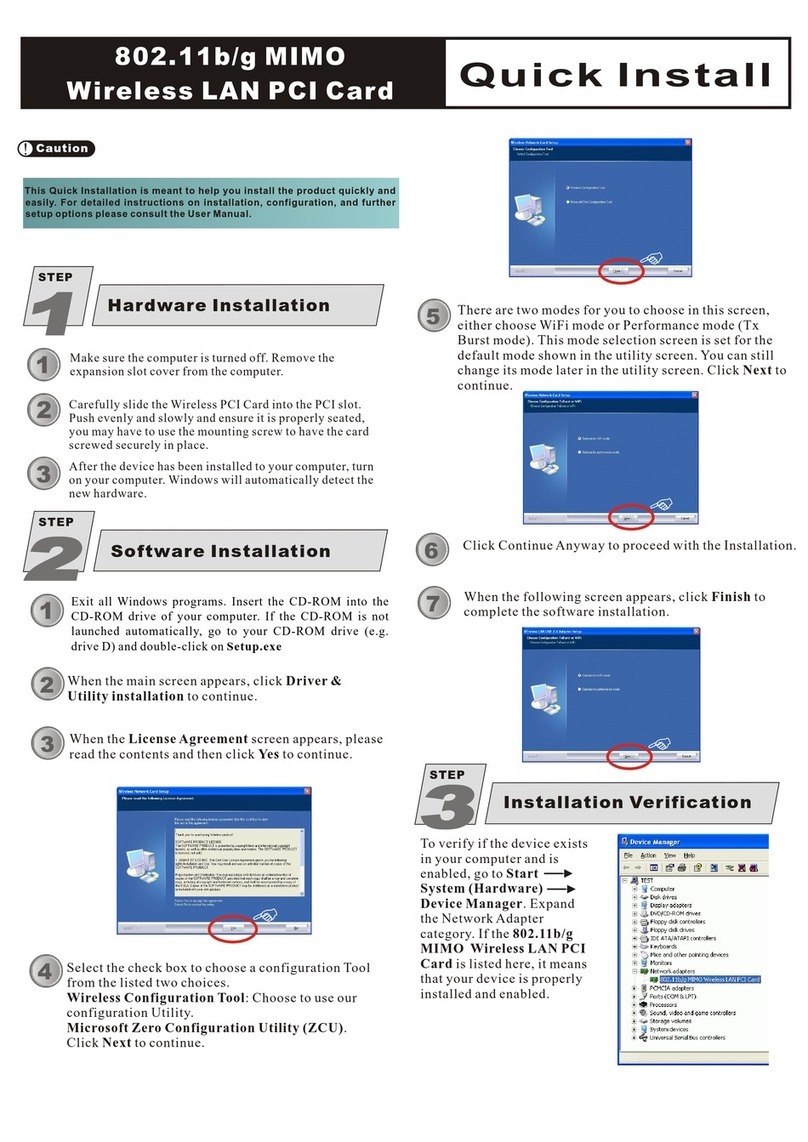
Abocom
Abocom 802.11b/g MIMO Wireless LAN PCI Card WCP5102 Quick installation guide

Datapath
Datapath VisionSC-HD4+ user manual
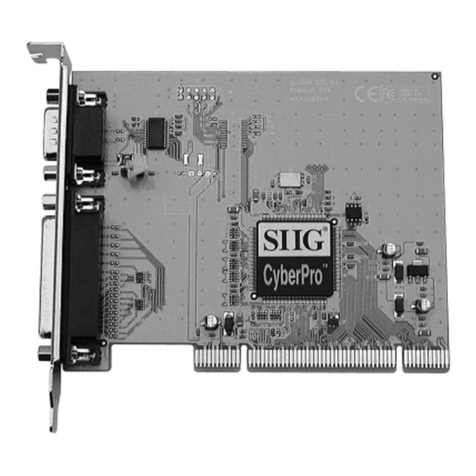
SIIG
SIIG Cyber 1S1P PCI Quick installation guide
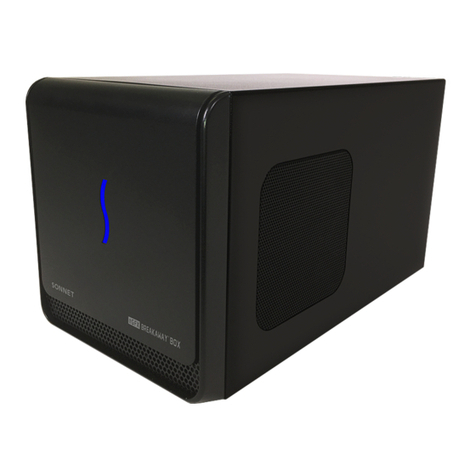
Sonnet
Sonnet eGFX Breakaway user guide
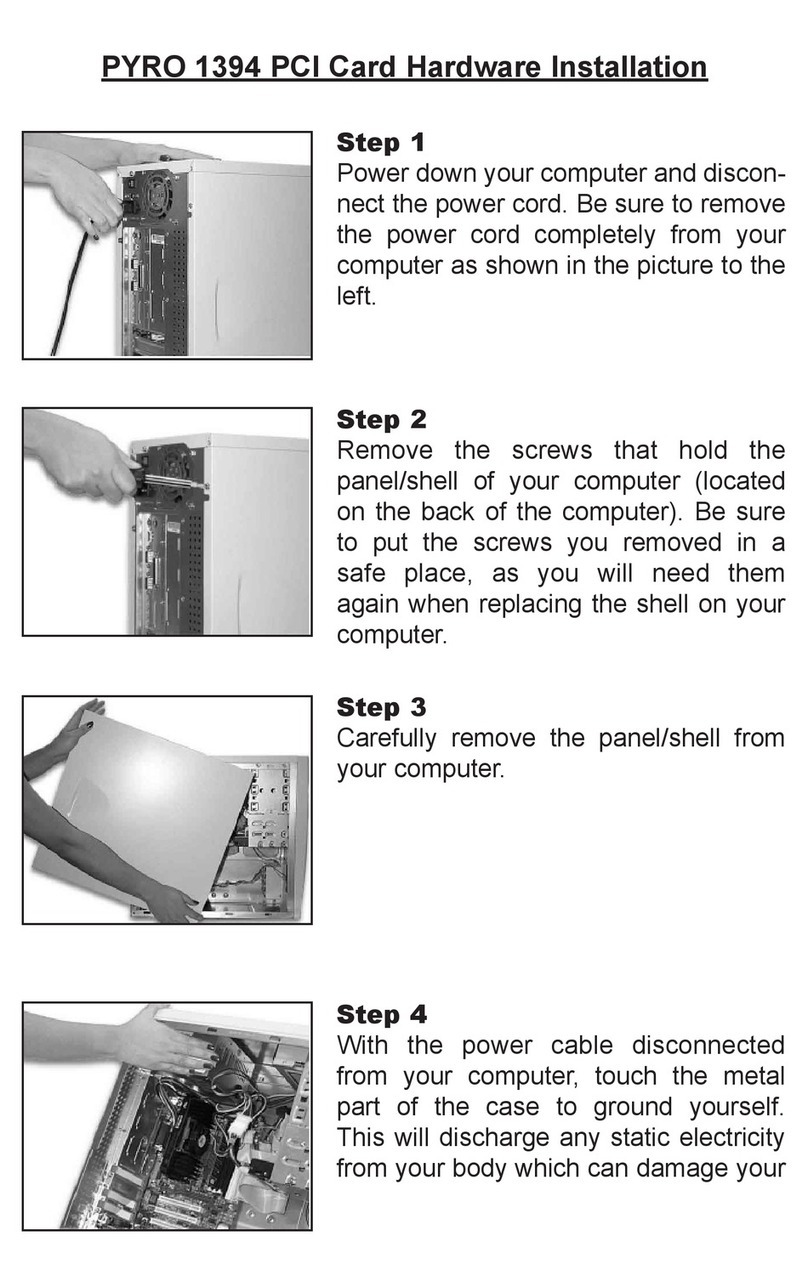
Pyro Industries
Pyro Industries API-1394PCI install guide

Conceptronic
Conceptronic EMRICK01G Multi Language Quick Guide
